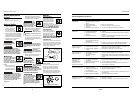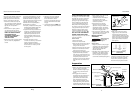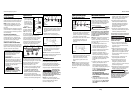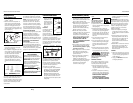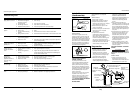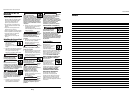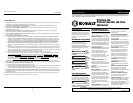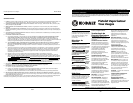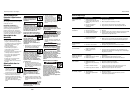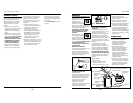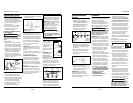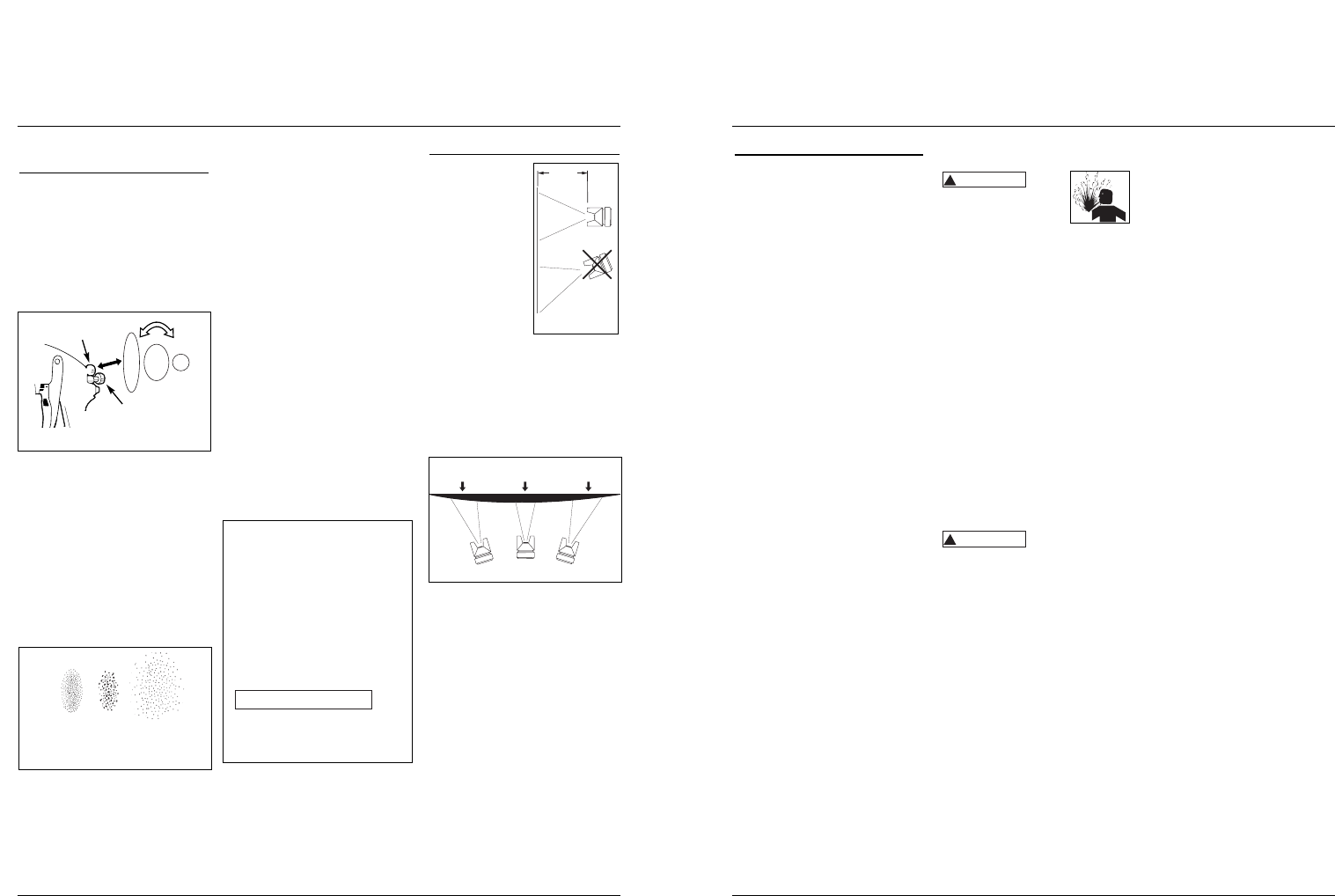
Si el rocio es muy tosco (gotas), reduzca
la cantidad de material con la perilla
de control de fluído o diluya la pintura.
NOTA: Si la pintura se chorrea, está
aplicando demasiada pintura. Si el
acabado luce como una “cáscara de
naranja”, la pintura está muy espesa.
Antes de comenzar a pintar, practique
unos minutos pintando en un cartón
para cerciorarse de que la consistencia
y tamaño del patrón sean los deseados.
AJUSTES DE DISTANCIA
Comience a 5,98 pulgadas (15,2 cm) de la
superficie de trabajo. Si el patrón
empieza a chorrearse, retroceda una
pulgada y pruebe otra vez. El patrón
quedará seco y delgado y puede sentirse
tosco al tacto si se rocía desde muy lejos.
AJUSTES DE LA VELOCIDAD DE
APLICACIÓN
Si la velocidad de aplicación es muy
lenta, la pintura quedará húmeda en la
superficie de trabajo y puede chorrearse.
Si la velocidad de aplicación es muy
rápida, la pintura se secará y no quedará
pareja en la superficie de trabajo.
Funcionamiento
1. Comience a rociar.
Siempre mantenga
la pistola en los
ángulos correctos
con el movimiento
de la muñeca para
pintar. (Vea la
Figura 6).
NOTA: No
mantenga la muñeca
fija cuando esté
usando la pistola, ni
pinte moviendo la
pistola en arcos como un abanico. Este
tipo de movimiento acerca la pistola a
la superficie y crea dépositos de
pintura que se concentran en el centro
del área cubierta aplicando muy poca
pintura en los bordes. Ésto ocasionaría
un acabado irregular y de mala calidad
(Vea la Figura 7).
Mantenga la boquilla de 6 pulgadas a
9 pulgadas (15,24cm a 22,86cm) de la
superficie que va a pintar todo el
tiempo y siempre mantenga la pistola
en movimiento mientras esté rociando.
Si para de moverla la pintura se
acumulará y se “chorreará”.
2. “Oprima el gatillo” adecuadamente.
Comience a mover la pistola ANTES
DE OPRIMIR EL GATILLO y deje de
oprimirlo ANTES DE PARAR DE
MOVERLA. Este procedimiento le
permitirá que el acabado sea parejo
sin dejar rastros de donde se unen
las diferentes manos de pintura (Vea
la Figura 8).
Preparacion
(Continuación)
presión generalmente es entre
2,07bar - 3,45 bar.
2. Seleccione la forma del patrón. Si
desea cubrir una superficie amplia,
gire la perilla de control en sentido
contrario a las agujas del reloj. Si
desea un patrón circular, gírela en el
mismo sentido de las agujas del reloj
(Vea la Figura 4).
3. Gire la perilla de control totalmente
en el mismo sentido de las agujas
del reloj, para cerrarlo.
4. Con la pistola a 8 pulgadas (20,3 cm)
de la superficie, oprima el gatillo por
un segundo, mientras gira la perilla
de control del
fluido en sentido
contrario a las agujas del reloj.
Observe el patrón de rociado en la
superficie y ajuste la perilla de control
del fluido hasta obtener el patrón
deseado (atomización) (vea la Figura
5).
Si el rocío es demasiado fino (malgasto
excesivo), debido al exceso de aire
para la cantidad de pintura que se está
rociando, reduzca la presión del aire o
abra el control de fluído para rociar
más material.
Figura 4 - Tamaño del Patrón
Perilla de Control
del Patrón
Perilla de Control
del Fluído
Maintenance (Cont.)
1. Spray guns with canister—Remove
and empty the canister; then rinse
with a solvent recommended for the
paint or other material used.
2. Refill canister with clean solvent and
attach to the gun. Spray solvent
through the gun while shaking the
gun vigorously. Wipe the gun
exterior with a solvent soaked rag.
Repeat until the gun is clean.
3. Remove the air cap and soak in
solvent until clean. Use a small brush
for stubborn stains if necessary.
Toothpicks or small brushes may be
used to clean air passages; however,
NEVER USE METAL OBJECTS TO
CLEAN PRECISELY DRILLED
PASSAGES. DAMAGED PASSAGES
WILL CAUSE IMPROPER
SPRAYING.
4. Clean gaskets with a solvent soaked
rag. To prevent equipment damage,
Do not immerse gaskets or spray
gun body in solvents.
5. After using water to clean out water
based paints or materials, spray
mineral spirits through the gun to
prevent corrosion.
6. Use a non-silicone oil on all moving
parts when reassembling. Use
Vaseline
®
or light grease on all
threaded connections prior to storage.
7. Clean and flush gun thoroughly to
neutralize any contaminants
corrosive to the spray gun.
5
20 Sp
Pistola Pulverización de Uso General
Model KBS530
CLEANING A GUN USED WITH A PAINT
TANK
Shut off the air supply to
the tank and release the
pressure in the tank.
1. Open the vent on the paint tank. If
using an external mix air cap, loosen
the cap slightly.
2. Reduce air pressure to 10-20 psi.
Hold a piece of wadded cloth tightly
around the air cap opening(s) and
pull the trigger. The air will back up
through the fluid tip and force the
paint out of the hose and back into
the tank.
3. Pour the paint from tank and use
solvent and rags to clean.
4. Put enough solvent into the tank to
wash the hose and gun thoroughly.
Close the tank and spray from the
gun until the solvent comes out
clean.
5. Remove and blow out the material
hose with compressed air to get rid
of any trace of solvent in the hose.
When blowing out
the hose, the open
end should be aimed away from any
person to avoid blowing solvent into
the eyes or on the skin causing
possible injury.
PERIODIC CLEAN-UP
Due to dirty, lumpy paint etc., it may
be necessary to inspect and clean the
internal parts and the gun body.
1. Examine openings in air cap and
fluid tip. If clogged, remove any o-
rings and soak the air cap or fluid tip
in solvent.
2. A brush or toothpick or something
similar may be used to dislodge the
dried paint from holes and passages.
NEVER USE METAL OBJECTS TO
CLEAN PRECISELY DRILLED
PASSAGES. DAMAGED PASSAGES
WILL CAUSE IMPROPER SPRAYING.
!
WARNING
!
WARNING
3. Remove and check the adjusting
needle for excessive wear at the tip
and straightness.
IMPORTANT: If the needle tip is worn
more on one side than the other, either
the needle is bent or the gun body has
been dropped or knocked out-of-line.
There are no adjustments that can be
made to a bent gun body. Test the
needle by rolling on a flat surface.
Replace if necessary.
4. Check and replace any damaged
o-rings and seals. O-rings and seals
can be wiped clean but not soaked in
solvent.
5. Unscrew packing nuts and replace
the packing ONLY if a leak will not
stop when the nut is tightened. Do
not over-tighten a packing nut
because this will restrict movement
of the needle.
6. Reassemble in reverse order of these
steps and use a non-silicone oil on
moving parts. Apply Vaseline
®
or
light grease on threaded joints and
hose connections.
STORING
1. When not using spray gun, turn the
fluid control knob counterclockwise
to open reducing spring tension on
needle fluid tip.
2. Spray gun MUST BE well cleaned
and lightly lubricated.
Correcto
Pintura
Muy
Espesa
Pintura Muy
Clara (Diluida)
Figura 5 - Consistencia del patrón
(Atomización)
15,24 cm
a
22,86cm
Figura 6
Muy Poca
Pintura
Demasiada
Pintura
Figura 7
INCORRECTO
Muy Poca
Pintura
PRESENCIA DE AGUA/ACEITE EN EL
AIRE COMPRIMIDO
Todos los cabezales expulsan cierta
cantidad de agua condensada, aceite o
contaminantes con el aire comprimido.
IMPORTANTE: Esta condensación
ocasiona un acabado disparejo al
pintar. Le recomendamos que instale
el equipo (tal como filtros y
secadores) y controles necesarios
para remover agua/aceite.
Si no
instala
el equipo adecuado para remover
agua/aceite podría dañar la maquinaria
o superficie que esté pintando .
AVISO




